The white-bellied sea eagle (Haliaeetus leucogaster) is a large bird of prey known for its impressive size and weight. As an apex predator, the white-bellied sea eagle plays a crucial role in maintaining the balance of its ecosystem.
The Average Weight of the White-Bellied Sea Eagle
The average weight of a white-bellied sea eagle can range from 1.8 to 4.5 kg (4.0-9.9 lb). Specifically:
- Male white-bellied sea eagles typically weigh between 1.8 and 3 kg (4.0-6.6 lb).
- Female white-bellied sea eagles are usually larger, weighing between 2.5 and 4.5 kg (5.5-9.9 lb).
It’s important to note that the weight of a white-bellied sea eagle can vary depending on several factors, including age, sex, health status, and the availability of food in its environment.
Factors Affecting the Weight of White-Bellied Sea Eagles
 Image source: bellied sea eagle by shankar s
Image source: bellied sea eagle by shankar s
Age
Young white-bellied sea eagles in their first year are predominantly brown, with pale cream-streaked plumage on their head, neck, nape, and rump areas. As they mature, their plumage becomes more infiltrated with white until they acquire the complete adult plumage by the fourth or fifth year. During this time, the eagle may weigh less than an adult bird due to its smaller size and less developed muscles.
Sex
As mentioned earlier, female white-bellied sea eagles are typically larger and heavier than their male counterparts, with some females weighing up to 20% more than males and being up to 120% larger in mass.
Health Status
The weight of a white-bellied sea eagle can also be affected by its health status. A bird that is sick or injured may weigh less than a healthy bird due to a loss of muscle mass or a decrease in appetite. Conversely, a bird that is well-fed and in good health may weigh more than the average weight range for its species.
Food Availability
The availability of food in a white-bellied sea eagle’s environment can also impact its weight. In areas where food is plentiful, eagles may weigh more than in areas where food is scarce. This is because eagles that have access to plenty of food are able to consume more calories and maintain a healthy weight, while eagles that are struggling to find food may lose weight due to a lack of sufficient calories.
Unique Characteristics of the White-Bellied Sea Eagle
The white-bellied sea eagle is a distinctive bird with several unique features:
- Plumage: Adult white-bellied sea eagles have a white head, breast, under-wing coverts, and tail, with grey upper parts and black under-wing flight feathers that contrast with the white coverts.
- Tail: The tail of the white-bellied sea eagle is short and wedge-shaped, as in all Haliaeetus species.
- Wingspan: The wingspan of the white-bellied sea eagle ranges from 1.78 to 2.2 m (5.8 to 7.2 ft).
- Behavior: White-bellied sea eagles are generally territorial, with some birds forming permanent pairs that inhabit territories throughout the year, while others are nomadic.
- Diet: The white-bellied sea eagle is an opportunistic carnivore and consumes a wide variety of animal prey, including carrion.
Conclusion
The white-bellied sea eagle is a remarkable bird of prey known for its impressive size and weight. While the average weight of a white-bellied sea eagle can range from 1.8 to 4.5 kg (4.0-9.9 lb), with females typically being larger than males, the weight of an individual eagle can be influenced by various factors, such as age, sex, health status, and food availability. Understanding the unique characteristics and weight range of the white-bellied sea eagle is crucial for its conservation and the maintenance of a balanced ecosystem.
References:
– White-bellied sea eagle
– Wedge-tailed Eagle vs. White-bellied Sea Eagle
– White-bellied Sea Eagle
– White-bellied Sea Eagle
– Wedge-tailed Eagle vs. White-bellied Sea Eagle
– White-bellied Sea Eagle

